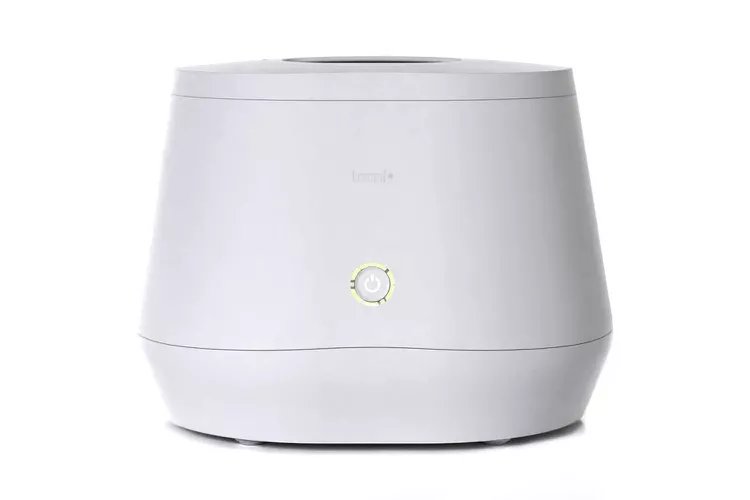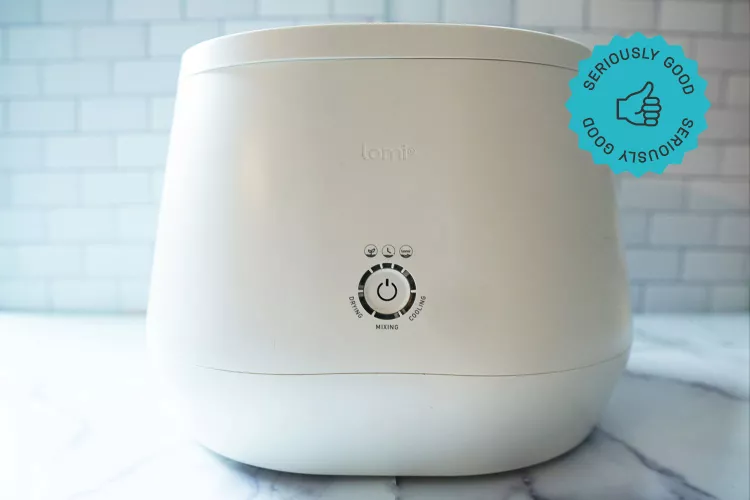Straight to the Point
The Lomi Composter performs effectively, albeit it occupies countertop space and has a somewhat finicky lid. Nevertheless, it boasts ample capacity and effortlessly manages various food scraps. If you’re considering purchasing a Lomi and have the room for it, we believe it’s a worthwhile investment that won’t disappoint.
Lomi Composter

The Lomi, manufactured by Pela—a certified B Corporation known for eco-friendly products like phone cases—was put to the test over six months, similar to my experience with the FoodCycler. During this period, I used it daily for food scraps, operated it as necessary, cleaned it regularly, and occasionally struggled with its lid. Despite these occasional frustrations, overall, I found the Lomi quite satisfactory, though with a few caveats.
What’s the Lomi and How Does It Work?
The Lomi composts food scraps by applying heat over several hours, transforming them into a soil-like substance termed “fertilizer” by Pela, which is suitable for various uses. Here’s how it operates:
- Eco Express Mode: This mode reduces waste significantly and is ideal for composting or adding to green bins. It typically takes three to five hours, though in practice, it may lean towards the longer end.
- Grow Mode: This mode runs for 16 to 20 hours, producing a nutrient-rich organic fertilizer. It’s designed for mixing into soil (at a 1:10 ratio) for houseplants, gardens, or lawns. It operates at a lower heat setting to preserve microbes.
- Lomi Approved Mode: This setting processes Lomi Approved products and packaging, like bioplastics, into compostable material for green bins. It takes five to eight hours for completion.
For those without access to green bins or outdoor composters, the Grow Mode offers a practical solution. The Lomi includes activated charcoal to minimize odors and LomiPods, which enhance nutrient content and accelerate composting.
The Good
The Lomi excelled in processing a wide range of food scraps effectively, including spent lemon halves, avocado shells, banana peels, coffee grinds, butternut squash seeds, and onion peels. It handled these items by grinding and drying them thoroughly, turning them into a usable end product.
Unlike some competitors, the Lomi provides clear guidelines on what should and shouldn’t be composted. It sensibly excludes liquids, nut shells, and fruit pits, which could potentially cause issues. The Lomi’s capacity is also noteworthy, holding up to three liters of food scraps, slightly more than the FoodCycler.
In terms of usability, its modern appearance and intuitive single-button control panel simplify operation. Icons indicate the selected mode, while a progress bar tracks the composting process stages (drying, mixing, cooling). The inclusion of charcoal inserts effectively manages odors, enhancing its appeal for home use.
The Bad
The lid design on the Lomi proved to be a point of frustration during use. To secure the lid, it requires twisting to lock it onto the unit, with indicators on the side to guide whether it’s in the locked or unlocked position. However, achieving a proper lock often proved difficult and finicky, demanding precise alignment. Many users, including myself, experienced multiple attempts to secure it correctly.
Additionally, the Lomi’s size is considerable, unlike the FoodCycler which offers a separate compost bin lid to store the bulky machine body elsewhere while keeping the bin in the kitchen. The Lomi lacks this feature, meaning the entire unit must remain on the countertop. Measuring approximately 18 inches long by 13 inches wide by 12 inches high and weighing about 20 pounds, it indeed occupies a significant amount of space.
The Verdict
The Lomi excels in its functionality, offering three distinct modes tailored for various composting needs. It effectively processes a wide range of food scraps and provides flexibility for different composting intentions, which is a significant advantage. However, potential buyers should consider a few caveats before purchasing, such as its substantial size, higher initial cost, and ongoing expenses for refill pods and charcoal inserts. If you have ample countertop space and are willing to make the investment, the Lomi is likely to meet your composting needs satisfactorily.
FAQs
The Lomi composter is available for purchase directly from the retailer’s website or possibly through other authorized retailers that carry Pela products.
In terms of composting times, it varies based on the mode selected:
- Eco Express: 3 to 5 hours
- Grow Mode: 16 to 20 hours
- Lomi Approved Mode: 5 to 8 hours
As for pricing:
- The Lomi composter itself costs about $500.
- Refills for charcoal and Lomi pods are approximately $50 and are designed to last for 45 cycles, according to the manufacturer’s information.







